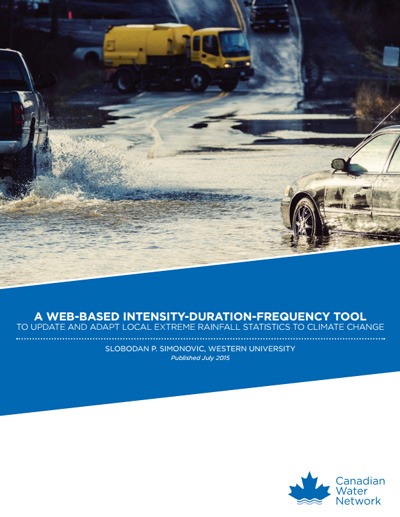Computerized Tool for the Development of Intensity-Duration-Frequency Curves under Climate Change
Slobodan P. Simonovic, Professor, Western University (2013-2014)

Challenge
There is a need in almost every Canadian municipality to adapt to and address changing climatic conditions. Addressing the change requires updating Intensity-Duration-Frequency (IDF) curves to integrate changing climatic information. There is a lack of necessary expertise within municipalities to implement current research related to the update of IDF curves. Thus, there is an opportunity to standardize the IDF update process and make previous research results accessible to everyone. Having a generalized IDF update tool will aid in the selection of effective adaptation options, and provide an opportunity to obtain feedback, which may lead to further research and innovation. Through consultations with the cities of Halifax, London, Hamilton and Coquitlam, a number of gaps from the previous research were identified, which form the basis of the proposed project.
This proposal built on the knowledge obtained from the following three projects:
- Project 1: (2003-2007) – Assessment of Water Resources Risk and Vulnerability to Changing Climatic Conditions: resulted in the development of a water resources risk and vulnerability assessment methodology, a climatic vulnerability assessment of the Upper Thames river basin, and guidelines for vulnerability reduction and hazard mitigation. Project Leader: Slobodan Simonovic, Western University.
- Project 2: (2008) – Development of Rainfall Intensity-Duration-Frequency Curves for the City of London under the Changing Climate: developed updated IDF curves for the City of London for three climate change scenarios. Project Leader: Slobodan Simonovic, Western University.
- Project 3: (2012) Updated IDF curves for London, Hamilton, Moncton, Fredericton, Winnipeg, Bathurst, Coquitlam, St, John’s and Halifax for Use with Municipal Risk Assessment Tool (MRAT): developed updated IDF curves for nine cities for three climate change scenarios. Project Leader: Slobodan Simonovic, Western University.
Municipal water management in Canada is heavily dependent on the use of IDF curves in planning, design, and operations of municipal water infrastructure. Many watershed management activities related to water supply, water quality management, flood control, and similar also rely on the use of IDF curves.
Project
The project was based on methodology that evolved from the initial research. Potential shifts in extreme rainfall at the local level were assessed using a combination of global climate modeling outputs and locally observed weather data. Global climate models were used to capture a range of potential changes in climatic conditions. Using updated IDF curves, generated either from historical data or from climate-modified data obtained using a weather generator model, two climate change scenarios were used to represent the lower and upper boundaries of possible future climate change.
A computerized IDF update tool was developed to help users update IDF curves that will capture precipitation changes caused by climate change. Statistical analysis tools and procedures were used to fill in missing data where necessary. The computerized tool consists of a database and a web-based user interface. The database system is responsible for storing historical precipitation data from all stations, station locations, climate scenarios, and user access data.
The web-based user interface is integrated with a Geographic Information Systems (GIS) tool to assist the user with the selection of station locations and background maps. By selecting a station, the user can carry out statistical analysis on historical data, as well as provide change factors for climate scenarios.
Outputs
- A modified methodology for IDF update that takes into consideration different climate change scenarios
- A computerized tool to standardize the IDF update process
- Technical documentation to facilitate use of the computerized tool
- Training sessions delivered to multiple municipalities across different regions of Canada
Outcomes
- Potential changes in practice by providing the necessary tools to keep information up to date and building capacity to use the tools.
- The project directly contributes to the improvement of design, management and operations of infrastructure under changing climatic conditions
- Informed decision-making by municipalities and watershed management authorities





